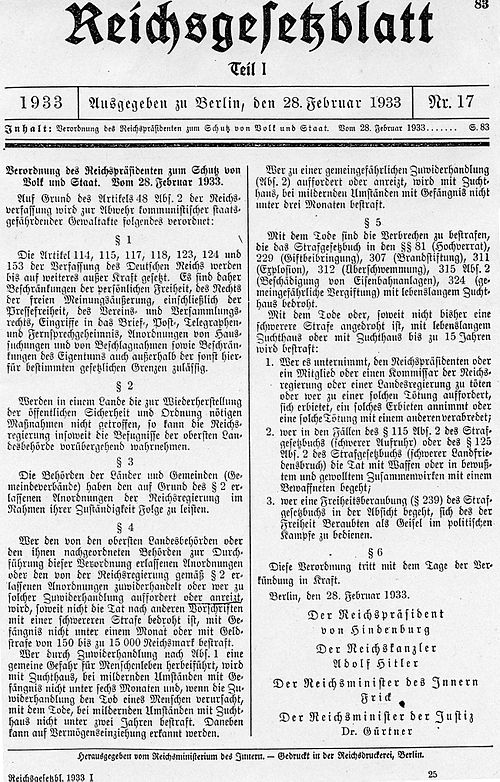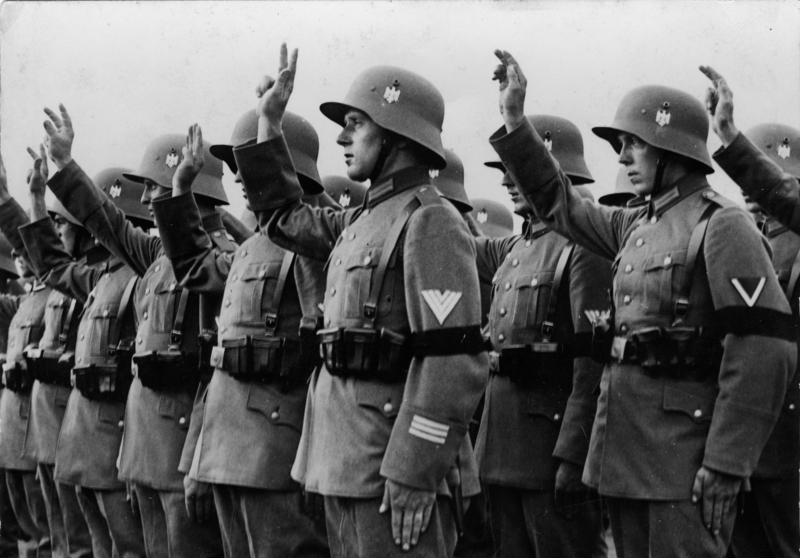OCR Specification focus:
‘Hitler’s consolidation of power, the Reichstag Fire, March Elections and Enabling Act, Gleichschaltung, creation of the one-party state, Night of the Long Knives, army oath and death of Hindenburg; system’
Hitler’s consolidation of power between 1933 and 1934 transformed Germany from a fragile democracy into a totalitarian state. This process combined legal measures, violence, and manipulation.
The Reichstag Fire
The Reichstag Fire of 27 February 1933 was pivotal in Hitler’s consolidation. The Reichstag building was set ablaze, and a Dutch communist, Marinus van der Lubbe, was arrested at the scene.
Hitler and the Nazis portrayed the fire as the start of a communist uprising.
The next day, President Hindenburg issued the Reichstag Fire Decree, suspending civil liberties such as freedom of speech, press, and assembly.
This gave the Nazis authority to arrest political opponents, especially communists and socialists.
Reichstag Fire Decree: Emergency legislation issued on 28 February 1933 that suspended key civil liberties, allowing the Nazis to suppress political opposition.
This decree effectively dismantled the democratic safeguards of the Weimar Republic and allowed the Nazis to campaign for the March elections in a climate of fear.

Published text of the Reichstag Fire Decree from the Reichsgesetzblatt. It suspended civil liberties and authorised sweeping police powers, providing the legal basis for mass repression. Source
The March 1933 Elections and Enabling Act
Despite repression, the Nazis failed to gain an outright majority in the March 5 elections, winning 43.9% of the vote. They relied on the support of the Nationalist Party (DNVP) to achieve a working majority.
Hitler’s real breakthrough came with the Enabling Act of 23 March 1933:
The Act allowed the government to pass laws without Reichstag or presidential approval.
It required a two-thirds majority to pass. The Nazis achieved this by:
Banning the Communist Party (KPD) deputies from taking their seats.
Intimidating the Social Democrats through violence and threats.
Securing Catholic Centre Party support by promising to protect the Church.
Enabling Act: Law passed in March 1933 granting Hitler’s cabinet the authority to enact laws without Reichstag consent for four years.
The Enabling Act provided the legal foundation for Nazi dictatorship and marked the effective end of parliamentary democracy.
Gleichschaltung: The Coordination of Germany
The Nazi process of Gleichschaltung (‘coordination’) aimed to bring all aspects of German life into line with Nazi ideology:
Political Parties: By July 1933, the SPD was banned, other parties dissolved themselves, and the Law Against the Formation of New Parties established a one-party state.
Trade Unions: In May 1933, unions were abolished and replaced with the German Labour Front (DAF).
Local Government: State parliaments were dissolved, and Nazi-appointed Reich Governors took control.
Media and Culture: Press, literature, and arts were censored and aligned with Nazi propaganda.
Gleichschaltung: The process of Nazification, where institutions, organisations, and society were systematically brought under Nazi control.
This restructuring eliminated alternative sources of power and enforced ideological conformity.
The Night of the Long Knives
A major threat to Hitler’s authority came from the SA (Sturmabteilung), led by Ernst Röhm. By 1934, the SA’s demand for a “second revolution” alarmed conservative elites, the army, and industrialists.
Between 30 June and 2 July 1934, Hitler ordered the Night of the Long Knives:
Röhm and other SA leaders were executed.
Conservative opponents such as former Chancellor Kurt von Schleicher were also killed.
The SS, under Heinrich Himmler, gained supremacy over the SA.
Night of the Long Knives: A purge in June–July 1934 where Hitler eliminated SA leaders and political rivals, consolidating his control and reassuring the army.
This event demonstrated Hitler’s willingness to use extrajudicial violence to secure loyalty and power.
The Death of Hindenburg and the Army Oath
On 2 August 1934, President Hindenburg died. Hitler immediately merged the roles of Chancellor and President, declaring himself Führer. A plebiscite confirmed his position with overwhelming (though manipulated) support.

Reichswehr soldiers swearing the oath of loyalty to Hitler in August 1934. The new oath tied the military’s allegiance directly to Hitler, strengthening his control over the state. Source
The army oath was now sworn not to the constitution or state but personally to Hitler:
This guaranteed army loyalty at a crucial moment.
It signified the final dismantling of constitutional checks.
Army Oath: A pledge introduced in August 1934 in which soldiers swore unconditional obedience to Adolf Hitler personally rather than to Germany or its constitution.
The military’s support secured Hitler’s dominance and ensured the stability of the Nazi dictatorship.
The System of Government under Hitler
By late 1934, Hitler had created a personal dictatorship:
One-Party State: The Nazi Party was the only legal political party.
Centralisation of Power: Authority was concentrated in Hitler’s hands as Führer.
Dual State: Alongside existing bureaucratic institutions, Nazi organisations such as the SS, Gestapo, and Party offices created overlapping responsibilities, encouraging competition and reinforcing Hitler’s control.
Cult of Leadership: The Führerprinzip (leadership principle) promoted absolute obedience to Hitler, presenting him as the embodiment of the German people’s will.
Führerprinzip: Nazi leadership principle dictating absolute obedience to Hitler, portraying him as infallible and the sole source of legitimate authority.
This system created a totalitarian state where law, politics, and society revolved around Hitler’s authority, established through a combination of legality, violence, and propaganda.
FAQ
Nazi propaganda portrayed the Reichstag Fire as part of a communist conspiracy, fuelling fear and justifying harsh emergency measures.
The Enabling Act was framed as necessary for “national unity” and stability, which gained support from moderate Germans.
Symbols, rallies, and speeches reinforced the idea of Hitler as Germany’s saviour, ensuring public acceptance of rapid political change.
The Catholic Centre Party agreed after Hitler promised to safeguard religious freedoms and maintain the Church’s role in society.
Their support was crucial in securing the two-thirds majority needed for the Act to pass.
However, these promises were later undermined by Nazi religious policies, showing the tactical nature of Hitler’s assurances.
Many conservatives, including the army leadership and industrialists, feared the radicalism of the SA under Röhm.
They pressured Hitler to act, stressing that continued SA militancy threatened order and the army’s support.
By purging Röhm and others, Hitler reassured these elites, gaining their backing for his dictatorship.
Führerprinzip demanded unconditional obedience to Hitler as the embodiment of the nation.
Officials and organisations competed to interpret his wishes.
This created overlapping authorities, encouraging radical initiatives.
Hitler’s authority remained unchallenged, as all power flowed from him personally.
The system reinforced a culture of loyalty and rivalry, strengthening dictatorship.
Previously, soldiers swore allegiance to the constitution and state, preserving institutional checks.
The new oath in August 1934 made obedience personal to Hitler, binding the military directly to him.
This removed the possibility of constitutional resistance from the army and guaranteed its compliance with Nazi policies.
Practice Questions
Question 1 (2 marks):
What was the Enabling Act of March 1933 and why was it significant in Hitler’s consolidation of power?
Mark scheme:
1 mark for identifying what the Enabling Act was (e.g. a law giving Hitler’s cabinet the power to pass legislation without Reichstag or presidential approval).
1 mark for explaining its significance (e.g. it marked the end of parliamentary democracy and gave Hitler legal authority to establish dictatorship).
Question 2 (6 marks):
Explain how the Reichstag Fire and the Night of the Long Knives contributed to Hitler’s consolidation of power between 1933 and 1934.
Mark scheme:
Up to 3 marks for accurate explanation of the Reichstag Fire (e.g. February 1933, blamed on communists, led to Reichstag Fire Decree suspending civil liberties, enabling arrests of opponents, strengthened Nazi election campaign).
Up to 3 marks for accurate explanation of the Night of the Long Knives (e.g. June 1934 purge of SA leadership including Röhm, eliminated rivals, reassured the army and conservatives, secured loyalty of the military).
To gain 5–6 marks, the answer must not only describe both events but also clearly link them to the theme of consolidation of power (e.g. showing how each removed opposition and strengthened Hitler’s authority).

